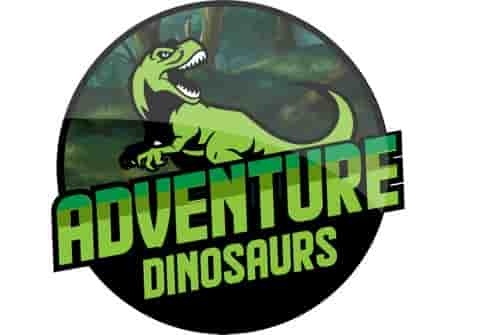Reptile Descendants: Turtles and Dinosaurs Are Related
“Are Turtles Related to Dinosaurs?” This age-old question captivates the imagination as we observe these ancient-looking shelled survivors, pondering their prehistoric connections. Their slow-paced existence and robust armors evoke a time when colossal creatures roamed Earth. Turtles, with their remarkable lineage stretching back over 200 million years, have witnessed the rise and fall of many species, including the mighty dinosaurs. Despite sharing their era with these behemoths, turtles are not direct descendants of dinosaurs. Instead, they are part of a group known as diapsids, which also includes dinosaurs, though they branched off early in the evolutionary tree. If they have been around so long and lived during the Mesozoic era, it makes me wonder – are turtles related to dinosaurs?
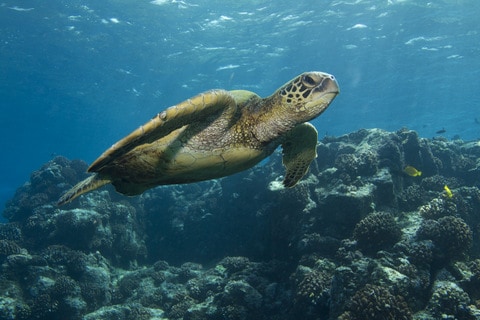
Are Turtles Related To Dinosaurs?
Turtles are related to dinosaurs, and the latest genetic studies suggest turtles share the same ancestor. The earliest turtles existed together with the dinosaurs millions of years ago. However, the connection to dinosaurs is somewhat distant and is considered to be closer to birds and crocodiles, than for instance, lizards and snakes. Descendants of ancient turtles are still present today, with most of them being species of sea turtles.
Key Takeaways
- Turtles and dinosaurs are genetically related, with ancient turtles coexisting alongside dinosaurs.
- Despite visual similarities, Therizinosaurus, often confused as a turtle, is actually a dinosaur.
- Modern and ancient turtles differ significantly in biological features, evidenced through fossil studies.
- Turtles and crocodiles share a closer genetic link, based on recent phylogenetic research.
- Changes in ancient turtle cladograms reveal shifts in their evolutionary history and classification.
- Sea turtles’ evolution, from ancient times to the present, has been comprehensively documented.
Turtles, grouped as Testudines, belong to the ancient reptile class, parallel to dinosaurs, indicative of their shared era, the Mesozoic. Both turtles and dinosaurs, as amniotes, share a common ancestor, suggesting a shared trajectory in evolution.
This evolution is made clear through paleontology using vital tools like fossils, including that of the extinct marine turtle, Archelon. The branches of biology, like taxonomy and herpetology, throw light upon these species, underscoring their interconnection in the natural world and address scientifically “is a turtle a dinosaur?”
Taxonomy identifies the common branch of turtles, dinosaurs and all reptiles, while herpetology illustrates the ecosystems occupied by these creatures. Significant insights into this intertwined history are obtained through the study of genetics, particularly DNA. Comparative DNA analysis underlines the common ancestry of turtles and dinosaurs.
Tying together these threads of fossils, taxonomy and genetics, a more vivid image of natural history of these species is painted. The role of critical events such as mass extinctions also figures prominently in this picture. Supporting these insights is the study of cladistics, highlighting the kinship between turtles and dinosaurs.
Despite the extinction of dinosaurs, their linkages to the surviving turtles underscore the ever-changing kaleidoscope of life on Earth. Thereby, while turtles are not directly descended from dinosaurs, understanding their shared lineage paints a richer picture of evolution.
As you read this article, you will be enlightened by how turtles became related to dinosaurs and the various changes in ancient turtles’ classification.
If you haven’t heard of the fossilized dinosaur initially thought of as turtle remains, you will encounter it here too.
Turtles Are Related To Dinosaurs
Turtles are reptiles, too and that alone provides a connection to our huge reptiles from millions of years ago, the dinosaurs. Although not as closely related as birds are to dinosaurs, the turtles still have a distant connection to dinosaurs.
Turtles, as Anapsids, display a solid skull with no temporal openings, setting them apart from dinosaurs. Dinosaurs, as Archosaurs, present a diapsid skull, distinguishing them from turtles. Nonetheless, both turtles and dinosaurs fall within the expansive group Archosauromorpha, connecting them evolutionarily.
The distinctive turtle shell, a unique attribute, traces its evolution within the Archelosauria clade, emphasizing its link to the dinosaur lineage. Even Lepidosauria, another reptile group, shares an evolutionary branch with turtles as they emerged from the early division of archosaurs.
This web of evolutionary paths underlines the shared archosauromorph ancestry between turtles and dinosaurs, reinforcing their genetic connection.
Crocodiles Are More Closely Related To Turtles
Dinosaurs and turtles are indeed distant relatives, and in between the two of them are the crocodiles. Birds are known to be direct descendants of dinosaurs. For a long time, anatomical and fossil studies are leaning toward the concept that birds are the closest living relative of crocodiles and alligators.
Crocodiles and dinosaurs, along with birds, also belong to the same group, the archosaurs. Meanwhile, even in scientific circles, it was previously believed that turtles are more related to snakes and lizards. (Source)
Now, more advanced genetic studies indicate that turtles are the crocodiles’ closest living relative. It seems that turtles and crocodiles share an almost sibling relationship on a molecular level.
Yes, they are all related to each other, but this shows that turtles are more closely related to crocodiles than dinosaurs. Additionally, it can be stated…” that turtles share a more recent common ancestor with birds and crocodilians than with lizards and snakes.” (Source)
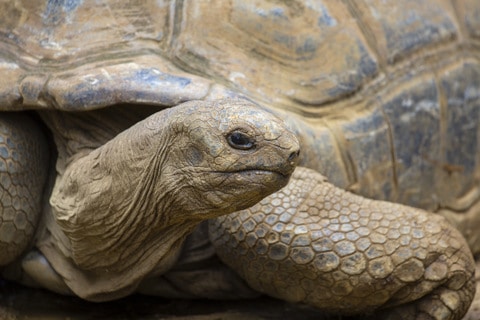
Why Turtles Are Related To Dinosaurs
Believed to have been around a long time ago, turtles are among the oldest and most primitive reptiles today. Scientists claim that ancient turtles lived along with dinosaurs approximately 110 million years ago, until the K-Pg extinction event, which wiped out the dinosaurs.
Crocodilians and extinct dinosaurs, and pterosaurs are all grouped as archosaurs (animals with a hole between the eye socket and nostril). According to a hypothesis backed up with DNA analysis, turtles and these archosaurs have common ancestors. If you would like to learn more about crocodiles, alligators and dinosaurs, check out my article: Are Alligators Related to Dinosaurs? (Classification, Similarities)
Another hypothesis is that turtles are anapsids (creatures with skulls with no side openings) while dinosaurs are diapsids (creatures with skulls with two openings). It is significant because diapsids are believed to have evolved from anapsids.
For both of these hypotheses, turtles are shown to be related to dinosaurs. It can either be that turtles belong to a sister group of dinosaurs under the same ancestor or that dinosaurs are more evolved versions of the turtles’ ancestors.
Ancient Turtles Coexisted With Dinosaurs
As I’ve mentioned earlier, turtles are the earliest reptiles that are still existing today, and that ancient turtles were present millions of years ago together with the dinosaurs. Let us now have a closer look at ancient turtles.
The Difference Between Ancient and Modern Turtles
Unlike modern turtles that are toothless, the discovered prehistoric turtles, often referred to as turtle dinosaurs, have teeth. The earliest ancient turtles, which raise questions like “are turtles dinosaurs?”, also lacked a shell with plastron and carapace, features that modern turtles normally have.
However, it is believed that these ancient turtle dinosaurs later evolved to provide stability and locomotion to modern turtles. This is attributed to their possession of broad ribbed structures, which are considered precursors for shells. These evolutionary traits have sparked curiosity and debate about the relationship between turtles and dinosaurs.
The evolution of the carapace (the top part of the turtle’s shell) is a wonderful example of how animals change over time. We can deduce from studying the bone structures in ancient turtles that evolved after the plastron (bottom part).
The modern-day turtle has not changed much from its ancient ancestors, which, in turn, links them to extinct dinosaurs. Fossilized ancient turtles also provided evidence that the two Suborders in modern turtles classification (the Pleurodira and the Cryptodira) are already present during the Triassic period.
Evidence That Ancient Turtles And Dinosaurs Existed Together
No living witnesses can claim that ancient turtles coexisted with dinosaurs, but scientists can prove it thanks to discovered fossilized turtles. An example of this is the fossilized footprint of a sauropod found along with a smashed Plesiochelys turtle shell.
Based on this, the sauropod was probably walking when it unconsciously stepped on the ancient turtle.
People might question how the turtles remain alive despite the dinosaurs becoming extinct if they truly existed together. Galapagos turtles are among the largest tortoises still existing but now are endangered.
An observation of Galapagos turtles shows that they have a slow metabolism and survive for days without eating. A similar ability with this, plus having a protective shell structure, could have helped ancient turtles survive the K-Pg extinction faced by other prehistoric reptiles.
How Turtles Are Grouped With Dinosaurs
Cladograms relate the evolutionary relationship between species, while biological classifications categorize based on observed similarities. Since turtles and dinosaurs are related, parts of their evolutionary history will also be connected, and some of their characteristics will be similar. The cladogram of turtles encountered various changes along the way, but a closer look at this can show how they are ancestrally linked to dinosaurs.
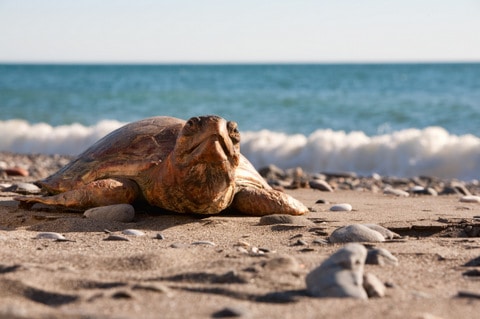
Changes In Cladograms Of Ancient Turtles
Initially, ancient turtles from the Triassic Period are believed to be the only surviving branch of the ancient group, Anapsida.
This table represents the historical evolution of the phylogenetic classification of ancient turtles. It encompasses the various stages of scientific discovery, from considering turtles as anapsids to the final placement in Archelosauria.
| Classification | Details | Associated Reptile Groups |
|---|---|---|
| Anapsids | Initial classification of ancient turtles. Later on, it was debunked when new phylogenetic studies suggested that they are diapsids. | N/A |
| Diapsids | Supported by more studies, scientists indicated that ancient turtles are closer to Squamata than Archosauria. | Squamata (scaled reptiles including lizards and snakes) |
| Archosauromorpha | Classification became complex as turtles were also being grouped in Archosauromorpha, a broader group where archosaurs are based on molecular evidence. | Archosauria (the archosaurs, which include the extinct dinosaurs) |
| Anapsids (Re-classified) | Scientists redid analysis, and the turtles were classified again as anapsids. | N/A |
| Lepidosauromorpha | A new phylogenetic study emerged which indicated that ancient turtles must belong to a much larger clade, the Lepidosauromorpha. | Lepidosauromorpha (the group of reptiles including lepidosaurs or those closer to lizards than to archosaurs). |
| Archelosauria | After discovering 1000 ultra-conserved elements in the genome unique to both turtles and dinosaurs, turtles were finally placed in Archelosauria. | Archelosauria (the turtles, birds, crocodiles, and even the dinosaurs in its group) |
Sea Turtles
It’s interesting to note that modern-day sea turtles are the closest descendants of ancient turtles, not the hard-shelled land-dwelling species. So, let’s take a look at sea turtles.
The oldest sea turtle fossils are about 140 million years old. It is around the time when dinosaurs lived on Earth. Ancient turtles like Protostega and Archelon lived during the Late Cretaceous (65 million years ago). Archelon is the largest turtle fossil reaching a length of 15 feet and estimated to weigh 4,900 lbs. Its fossils were found in South Dakota. Interestingly, its shell was not hard but leather-like in texture.
The Archelon fossils were found in South Dakota in 1895. Other sea turtle fossils have been found in South America, Middle East, China, and Australia.
Sea turtles are reptiles and come from the Chelonioidea family of sea creatures. They were first thought to be a type of lizard, but they belong to their group. Sea turtles are an order of reptiles with approximately 300 species.
Sea turtles live almost exclusively in the sea, but some species wander into brackish water and freshwater habitats. All sea turtle species belong to the superorder Chelonia, which also includes tortoises.
Biological Classification Of Modern-day Turtles
A clade is a group of organisms believed to have evolved from a common ancestor, but it is not a taxonomic ranking used for biological classification. In the 1950s, Testudines became the formal name for turtles. Testudines are under the clade Archelosauria, but in terms of taxonomy, Order Testudines are under the Class Reptilia. Dinosaurs are also under Class Reptilia.
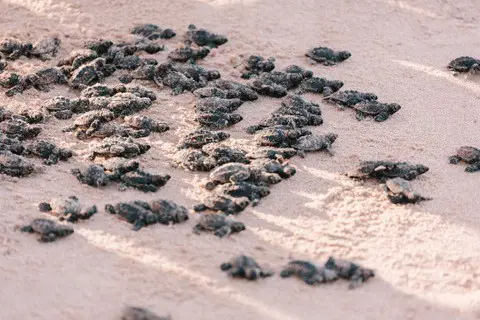
That is why turtles and dinosaurs share common reptilian characteristics such as the ability to lay eggs, be air-breathing vertebrates, and have scaly or bumpy skin.
Under the order of Testudines are two suborders separated based on how the turtle’s neck folds. Suborder Cryptodira is the vertical or S-necked turtles that have a total of 263 species in 11 families.
At the same time, Suborder Pleurodira includes the snake-necked, side-necked, and big-headed turtles, which total 93 species in 3 families. Succeeding classifications after the suborders are based on differences in the modern turtles’ skull and shell.
————————————————————————————————
Related Dinosaur Articles You Might Also Be Interested In:
Gobi Desert Dinosaurs – The Amazing Fossil Discoveries
What Was The Dinosaur With The Bump On Its Head? The Hard-Headed Dinos
The 9 Closest Living Things to Dinosaurs (Not Only Birds)
————————————————————————————————
Therizinosaurus: The Turtle-Looking Dinosaur
One of the most famous cases where a dinosaur was mistaken for a turtle is Therizinosaurus. This ancient reptile was first thought to be an early turtle, but it turned out that this “turtle” had giant claws on its feet and huge teeth at the end of its snout!
Similar Features With Turtles
When the Therizinosaurus fossils were first discovered in Mongolia, it was thought to be a turtle. In 1954, a Russian paleontologist claimed that the fossils resemble a modern sea turtle. It led to an assumption that the Therizinosaurus fossils were fossils of ancient turtles. The turtle like dinosaur had unique forelimbs are initially believed to be powerful swimming organs, while its large claws for cutting vegetation underwater. These features also made the creature comparable to ancient turtles.
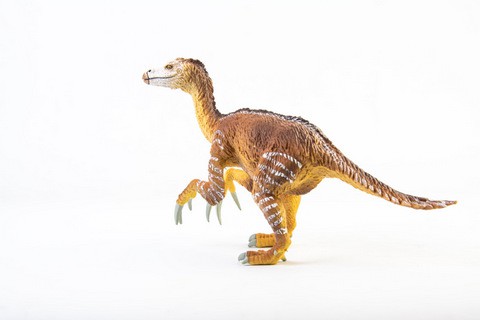
The Therizinosaurus Is Not A Turtle
Now let’s discuss the dinosaur turtle, of which there was some confusion because of its fossils. After some time, experts finally realized that Therizinosaurus fossils are not from a turtle but a dinosaur.
About the Therizinosaurus
After assembling the fossil’s general skeletal structure, the structure showed that it is a theropod dinosaur. The Therizinosaurus has a small head, long neck, and a beaked mouth. It is bipedal with four clawed toes, but only three toes support its weight. It has two hands, each with three gigantic claws.
Although it has huge claws, its diet is believed to be a plant-eating dinosaur. If you want to know more about the Therizinosaurus, check out my articles What Was the Herbivore Dinosaur with Long Claws? Some Surprising Facts and Gobi Desert Dinosaurs – The Amazing Fossil Discoveries
Coming Back to Turtles – Defining Characteristics Of Turtles
The Therizinosaurus is not a turtle because of various reasons. Turtles are reptiles with hard shells for protection which are absent on the discovered Therizinosaurus fossils. A turtle’s shell includes its modified ribcage, and a part of its vertebral column with the top part called the carapace while the bottom part is called the plastron.
Turtles cannot escape their shells nor shed them like skin. Unlike the Therizinosaurus, they use four legs for movement and have short tails.
To answer the question, are tortoises dinosaurs, we should look at the bigger picture and classification. Technically speaking, turtles only survive in an aquatic environment, tortoises are those surviving inland, and terrapins are those that can live on both. Usually, when you use the term “turtle,” it can represent all the mentioned creatures in the entire Testudines Order.
Conclusion
Turtles and dinosaurs go way back. Millions of years ago, they were living side by side. Genetic evidence shows the two have similarities that can’t be ignored. It’s not just a coincidence that one of them was mistaken for the other!
I feel like turtles can intimidate me now because they are indeed related to dinosaurs. Kidding aside, I’ll probably marvel at their interesting prehistoric ancestry the next time I come across a turtle.
Frequently Asked Questions
Are All Turtles Dinosaurs?
No, turtles are not dinosaurs. While both groups are reptiles, they are not closely related. Dinosaurs lived millions of years ago and went extinct, while turtles have been around for over 200 million years and continue to thrive today. Turtles have unique characteristics, such as their hard shells and ability to retract their heads and limbs, that set them apart from dinosaurs and other reptiles.
When Was the First Turtle?
The first turtle appeared over 220 million years ago during the Triassic period. It is believed that turtles evolved from a group of reptiles called procolophonids, which had a similar body structure. The earliest known turtle fossils were found in China and they had a fully developed shell, indicating that the evolution of the turtle’s unique feature occurred relatively quickly.
What Did Turtles Evolve From
Turtles evolved from reptiles that lived over 200 million years ago. These reptiles were similar to modern-day lizards and had a shell-like structure on their backs. Over time, this structure evolved into the hard, protective shell that we see on turtles today.
Which Came First Turtles or Dinosaurs?
Dinosaurs came first, as they first appeared in the fossil record around 230 million years ago. Turtles, on the other hand, did not appear until around 220 million years ago, during the Triassic period.
How Are Dinosaurs and Turtles Related?
Dinosaurs and turtles share a common ancestor that lived over 260 million years ago. They are not the same species, but they are distant relatives on the reptilian family tree.
Is the Turtle a Descendant of The Crocodile, Just Like the Dinosaur?
No, turtles are not direct descendants of the crocodile. While they share a common ancestor, their evolutionary paths have taken different courses with turtles emerging over 260 million years ago, much before the crocodile.
What Distinguishes Turtles from Dinosaurs Since Turtles Are Not Dinosaurs?
Turtles are distinguished from dinosaurs by certain traits. For example, turtles may have a slow metabolic rate that allows them to lead unordinarily long lives. On the other hand, dinosaurs were fast-growing creatures.
How Did the Extinction of The Dinosaurs Impact Turtles?
Turtles were largely able to survive the mass extinction that wiped out the dinosaurs 66 million years ago, likely due to their adaptive capabilities to live in ocean and on land.
Were Turtles Present at The Same Time as Dinosaurs?
Yes, turtles were around at the same time as dinosaurs, with dinosaurs and turtles emerging from a common ancestor over 260 million years ago. Turtles, as we see today, evolved around 80 million years ago.
What Was the Largest Turtle that Ever Existed and How Does It Compare to The Largest Dinosaur?
The largest turtle ever, known as the Stupendemys, could grow up to 13 feet long! That’s huge, but not nearly as large as the largest dinosaur, the Argentinosaurus, which could reach lengths of up to 100 feet.
Were Any Dinosaurs Similar to Turtles in Terms of Physical Characteristics?
Yes, the Ankylosaurus, a type of dinosaur, had a heavily armored body similar to the hard shell of a turtle. It was like a giant walking tank, much the way some people imagine turtles.
Can We Find Similarities Between a Turtle’s Flipper and Any Part of A Dinosaur?
It’s hard to draw a direct comparison between a turtle’s flipper and any particular part of a dinosaur. The flipper is a specialized limb for swimming, while dinosaurs, for the most part, were terrestrial creatures.
Are There Any Shared Genetic Characteristics Between Turtles and Dinosaurs?
Yes, despite their physical differences, turtles and dinosaurs share a significant amount of DNA, which is not surprising given their shared ancestry.
Did Certain Turtles and Dinosaurs Have Similar Diets?
Yes, several species of ancient turtles were omnivores, much like many dinosaurs, and would have had dietary overlaps, like feeding on crustaceans.
